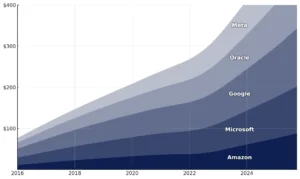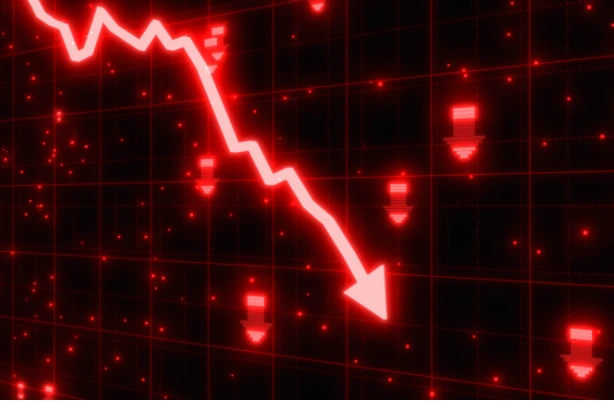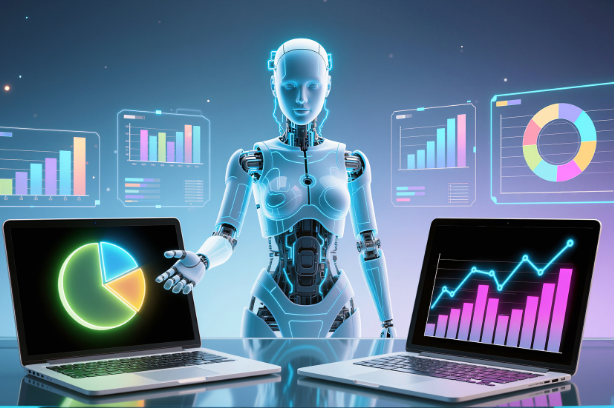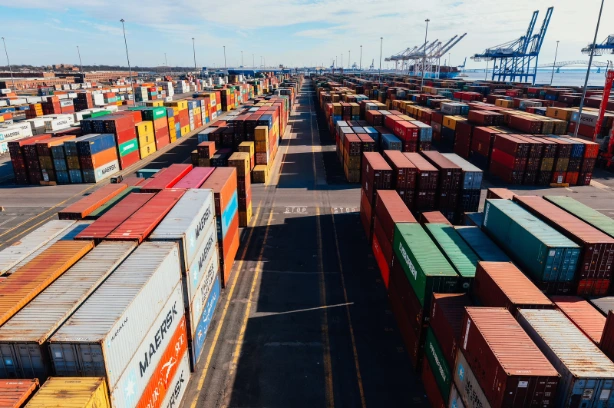By Preserve Gold Research
“Before coming to the office, check personal/work email… including spam, for a message on your role.” This was the message that 14,000 Amazon employees received overnight as the company announced it was eliminating jobs in its corporate offices in late October. While CEO Andy Jassy insisted the move wasn’t about artificial intelligence, it’s hard to ignore the timing, given Amazon’s massive investment in AI and automation.
In his remarks to analysts, Jassy emphasized that “given the transformation happening across business and technology, it’s more important than ever to be lean, flat, and fast-moving.” Many viewed the comment as a not-so-subtle acknowledgment that the company’s next phase of efficiency may depend less on labor and more on algorithms.
While Amazon’s layoffs made headlines around the world, they’re just a small piece of a larger trend sweeping businesses in recent years. Recent advances in artificial intelligence have enabled the automation not only of routine manual work but also of a growing share of white-collar tasks once seen as insulated. As competitive moats continue to narrow, companies are looking for any edge they can find. And for many, replacing human labor with lower-cost AI systems appears to offer a quick path to more agreeable earnings calls.
Companies Worldwide Accelerate Workforce Reductions Through AI
In June, Jassy suggested that AI would lift Amazon’s workforce out of “rote tasks”. He framed it as a step toward greater efficiency. Of course, many workers quietly wondered whether “rote” might be nothing more than a polite placeholder for “all”. Jassy later added that AI would make every job “more interesting,” and it certainly has, for those fortunate enough to survive the chopping block.
Only a few years ago, the threat of AI sweeping through the labor market felt distant. Today, that sense of distance has faded as generative systems have matured into veritable job-replacing machines. In 2025, U.S. employers attributed tens of thousands of layoffs to AI implementations, particularly in the tech sector.

Tech giants are pouring record billions into AI as capex surges across Meta, Google, Microsoft, Amazon, and Oracle, reinforcing the view that AI is becoming their primary strategic priority. Source: Company filings
Outplacement firm Challenger, Gray & Christmas reported that more than 17,000 job cuts were directly tied to AI in the first nine months of 2025, with a spike of 7,000 AI-related layoffs in September alone. “Tech firms are undergoing incredible disruption with AI that is not only costing jobs, but also making it difficult to land positions, particularly for entry-level engineers,” noted Andy Challenger, a senior VP at the firm. “Tech leaders have stressed that AI is changing the nature of work, and more companies are requiring their teams to be trained on it,” he added.
Almost every month, high-profile cases like Amazon’s capture headlines, fueling concerns about AI’s impact on employment. “This is a wake-up call. And if Amazon does it, other companies might do it too,” warned Harry Holzer, a Georgetown public policy professor and former Chief Economist at the U.S. Labor Department. Around the same time as Amazon’s announcement, Salesforce’s CEO revealed that 4,000 customer service jobs had been eliminated after the company deployed AI chatbots to handle customer inquiries, reducing its support staff from 9,000 to about 5,000.
Similar patterns have surfaced outside Silicon Valley. German airline Lufthansa announced it would cut 4,000 roles by 2030, citing “increased use of artificial intelligence” in its operations. Online education company Chegg, faced with students turning to new AI tools like ChatGPT, saw its web traffic decline and subsequently slashed 45% of its workforce in 2025. These anecdotes illustrate a trend: AI is already directly displacing jobs when it can perform tasks traditionally performed by humans.
The data paints an even starker picture. Surveys indicate nearly 1 in 4 U.S. companies (23.5%) have already replaced workers with ChatGPT or similar AI tools, and almost half of all companies using such AI acknowledge it has directly displaced workers. By 2030, an estimated 14% of the global workforce may be pushed into new careers because of AI. By 2045, analysts warn that half of today’s jobs could be automated. In a relatively short span, AI has gone from a promising new tool to a justification for workforce reduction, a shift that hints at deeper pressures building beneath the surface of the world economy.
Jobs Most at Risk: Who Is Being Affected?
AI is reshaping the labor market in ways that would have sounded speculative only a few years ago. Analysts argue that the real story lies not just in the volume of displacement but in its pattern. The technology has advanced most aggressively in roles built on predictable cognitive tasks—positions once seen as the backbone of modern office work. Data entry, customer support, and even large portions of software development have begun to feel the strain.
An August 2025 working paper by Stanford economists Erik Brynjolfsson, Bharat Chandar, and Ruyu Chen reported that from late 2022 through July 2025, entry-level employment in these areas fell by nearly 20%. Firms are increasingly paring back customer support teams, entry-level coders, content marketing writers, data processors, and administrative roles that algorithms can now handle with surprising efficiency.
Meanwhile, there’s been little sign of widespread automation in manual labor or high-complexity physical work. As Lynn Wu, a Wharton professor, observed amid Amazon’s cuts: “Amazon is not cutting warehouse workers. Robots can’t do what hands do yet… And very high-skill workers—people developing robots and building AI—are still in high demand.” The burden is falling on middle-skilled white-collar jobs, a segment that may become increasingly vulnerable as firms explore new ways to compress costs amid rising economic uncertainty. This concentration of risk hints at a labor market undergoing a slow realignment that could widen existing economic fault lines.
Researchers began mapping the distribution of risk as early as 2024, and their findings share a consistent thread. Entry-level and routine-based roles carry the greatest near-term exposure. A recent analysis by Bloomberg suggests that AI could replace more than half the tasks performed by market research analysts and sales representatives, a larger share than what managers in the same fields might face.
Clerical and administrative roles, including bookkeeping, scheduling, and data entry, appear repeatedly on lists of likely early automation. In retail and banking, we’re already seeing declines: the employment of bank tellers and cashiers is projected to drop over 10-15% this decade as ATMs, online banking, and self-checkouts replace routine transactions. Similar trends are affecting call center staff and telemarketers, where chatbots and automated voice systems have become the norm.
Manufacturing jobs have long been vulnerable, and AI-driven robotics continues that trajectory. Since 2000, roughly 1.7 million U.S. manufacturing jobs have been lost to automation. What stands out in the current wave is that white collar roles are now at risk as well. Generative AI systems can draft reports, summarize legal documents, write code, and answer customer questions with startling speed. The World Economic Forum’s Future of Jobs Report 2025 notes that nearly 40% of employers expect reductions in roles where AI could perform core duties. U.S. estimates show a similar pattern: over 30% of current American jobs could be fully automated by 2030, with an additional 60% of jobs seeing significant portions of their tasks changed by AI integration.
Young and inexperienced workers are particularly vulnerable. For decades, entry-level roles have been the on-ramp for new graduates to gain skills. Now those very roles are shrinking. “Are entry-level jobs on the way out?” asked one World Economic Forum analysis, warning that AI is narrowing the entry pathways that college grads traditionally relied on. Estimates suggest that as many as 50 million U.S. jobs could be affected in the coming years, many concentrated in early-career roles that involve repetitive information handling.
According to Dario Amodei, CEO of Anthropic, one of the world’s leading artificial intelligence research companies, AI could erase half of all white-collar entry-level jobs over the next 1 to 5 years. “Most of them are unaware that this is about to happen,” Amodei warned. “It sounds crazy, and people just don’t believe it.”
If routine junior tasks are automated, companies might hire fewer graduates or offer lower wages. Already, surveys suggest nearly half of Gen Z job seekers (49%) feel that AI has reduced the value of their college degree in the job market. Many worry that a machine can already perform the tasks they were trained to do. The remaining entry-level roles often require fluency in AI tools, raising the threshold for what qualifies as an entry-level role.
This hollowing-out of entry-level opportunities poses a “talent pipeline” problem for the future. If fewer newcomers get the chance to start a career and learn on the job, how will organizations cultivate the next generation of managers and experts? Inequity could widen if only those with personal connections or elite skills get a foot in the door. As Bloomberg notes, reduced entry ramps have “significant implications for social mobility and equal representation” in industries over time. In simpler terms, AI may be closing off the professional pathways that once helped diversify the workforce..
Temporary Turbulence or Paradigm Shift?
Viewed from above, the economic signals of AI’s rise look deceptively calm. Unemployment has crept up only slightly, job postings remain available in many sectors, and headline indicators haven’t reflected any massive rupture. Skeptics have found reassurance in an October 2025 analysis by researchers at Yale, which found no broad AI shock at the macro level. But even that report quietly acknowledged that “the occupational mix is changing more quickly than it has in the past.” The surface-level calm may be masking a slow-moving realignment that could gain force as more firms adopt automation.
Historical comparisons offer less comfort than they once did. It’s true that past technologies eventually created new work, but the promise of eventual adjustment may not shield workers from severe and prolonged disruption. Goldman Sachs researchers estimated that 6 to 7% of the U.S. workforce could be displaced as AI scales, and even their optimistic scenario expects unemployment to rise above baseline. They noted that prior eras of innovation ultimately produced new occupations, yet the path between displacement and reintegration can stretch painfully long. There is no guarantee that AI-generated work will emerge fast enough or widely enough to absorb the workers who lose their jobs today.
AI may replace human labor faster than companies can build the complementary roles that soften the blow. Some economists liken this to ‘frictional unemployment,’ in which displaced workers spend months or even years searching for new positions, retraining, or stepping out of the labor force altogether. Of course, there’s also the possibility that businesses decide not to channel the gains from AI into fresh hiring, instead opting to direct those savings toward shareholders.
A more troubling scenario sits at the center of the current debate. Skeptics worry that AI could be uniquely disruptive, leading to a “decoupling” of productivity from employment, where companies can grow without adding workers. Daron Acemoglu (MIT economist and recent Nobel laureate) and Simon Johnson have warned that, if left solely to market forces, AI could skew toward excessive automation that suppresses wages and worsens inequality, without necessarily increasing overall prosperity. Their concern is that the economy’s structure could shift toward fewer jobs, fewer pathways into stable careers, and fewer opportunities for upward mobility.
Even analysts who take a more balanced view, such as Georgetown’s Harry Holzer, concede that the future remains uncertain and that policymakers may need to respond quickly if displacement accelerates. That uncertainty is the most concerning signal of all. The economy may be in the quiet part of the cycle, where surface stability masks a buildup of pressure below. If AI adoption moves to full-scale deployment, the transition could arrive faster than the labor market can absorb.
The Human Cost Behind AI Driven Layoffs
Behind every layoff tied to AI sits a worker confronting sudden uncertainty. The shift rarely feels abstract to those living through it. Even workers whose positions appear safe feel a growing sense of unease. Many worry that an algorithm might eventually outperform them, or that their employer could decide to automate their role before they have a chance to adapt. Surveys show that nearly a third of U.S. workers fear their jobs could be replaced by AI this year.
This fear has already erupted into visible confrontation. The Hollywood strikes of 2023 revealed how quickly creative workers recognized the existential threat posed by AI encroachment. Writers and actors fought to keep studios from using generative AI to draft scripts or replicate digital likenesses, and their success in placing limits on AI use may not only protect their craft but also signal a broader resistance movement. The intensity of the dispute suggests that other industries might follow a similar path as workers try to negotiate for control before technology transforms their livelihoods.
Even outside formal labor actions, people are reshaping their lives as AI rises. Students are increasingly flocking to technical majors because they fear their chosen field could vanish before they graduate. Workers in mid-career are scrambling to build new skills in data analytics, automation oversight, or AI-assisted customer relations, hoping to remain employable. But this race to adapt carries a cost. Many workers juggle long hours, family responsibilities, and financial pressures, leaving little time for extensive retraining. The burden raises uncomfortable questions about who bears responsibility for preparing the workforce for rapid technological change. If companies and governments don’t fund meaningful retraining, the gap between those who can adapt and those who cannot may grow wider.
There is also a clear geographical layer to AI’s labor impact. In the same way that manufacturing automation once struck the Midwest and South with unusual force, the first wave of AI displacement has fallen unevenly across the country. Early indicators point to major tech hubs such as Silicon Valley, Seattle, and Austin, where firms are already trimming roles that AI can readily absorb. Rural regions may face fewer losses simply because they have fewer AI-susceptible jobs. Still, they are not insulated. If AI enables more remote production, centralized operations, or corporate consolidation, smaller towns could see opportunities drift away before they have a chance to replace them.
Inequality stands at the center of the broader social risk. AI tends to reward a small group of people who develop and own the technology, while exposing a much larger segment of workers to wage stagnation and downward mobility. A recent World Bank commentary warned that the most acute danger may not be a sharp rise in unemployment but a surge in inequality and exclusion. A labor market split between highly paid technical specialists and a fragile service workforce could unsettle the social order, especially if mid-income roles continue to thin out. Without meaningful guardrails, AI might act as another accelerant to the inequality already weighing on American households.
Strengthening Your Financial Foundation as AI Redefines Industries
The first wave of AI-driven displacement has made one thing painfully clear. Workers, companies, and institutions will have to navigate a period of unusual volatility in the coming years. Adaptation becomes less a strategy and more a survival imperative. At the individual level, that may mean continuous skill building and a willingness to rethink familiar roles. A marketing professional who once relied on intuition may now need to pair that instinct with AI-powered analytics. For businesses, the transition may be equally fraught. A rapid purge of staff could yield short-term savings, yet it may hollow out institutional knowledge, damage morale, and erode trust with customers.
The broader truth is that the transition now unfolding doesn’t guarantee stability. AI is capable of reshaping industries at a pace that exceeds any previous technological cycle. Workers sense this acceleration. Companies sense it as well. Households, already squeezed by inflation and financial uncertainty, may find themselves navigating a future that feels more fragile than the one they prepared for.
During times like these, families often look for anchors that might help them hedge against the unknown. Throughout history, periods of technological disruption and economic flux have nudged people toward assets that hold their value when confidence wavers. Gold, one of the oldest and most widely recognized forms of money, often plays that role. It may not resolve the challenges posed by AI, yet it can serve as a stabilizer in an era when the ground beneath workers is shifting more quickly than they expected.








